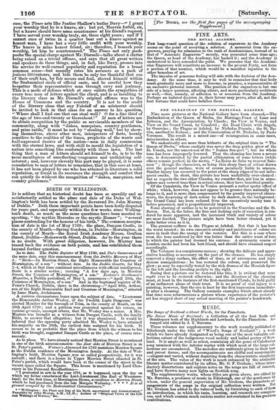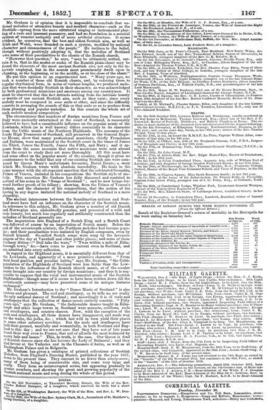MUSIC.
The Songs of Scotknel without Words, for the Pianoforte.
The Dance Music of Scotland; a Collection of all the best Reels and Strathspeys both of the Highlands and Lowlands, for the Pianoforte. Ar- ranged and edited by J. T. Surenne.
These volumes are supplementary to the work recently published at Edinburgh under the title of "Wood's Songs of Scotland " ; a work which we have already designated as being one of the most valuable col- lections extant of the indigenous vocal melody and ballad poetry of Scot- land. It is ample as well as select, containing all the gems of Caledonian song unmixed with the inferior matter with which most of the large col- lections are encumbered. The melodies are uniformly given in their best and purest forms.; and the accompaniments are skilful and musicianlike —elegant and varied, without departing from the characteristic simplicity of the airs. The value of the work is much enhanced by the admirable literary matter contributed by its editor, Mr. G. F. Graham ; whose intro- ductory dissertations and copious notes on the songs are full of interest, and have thrown many new lights on Scottish song. The supplementary works, whose titles are given above, are edited by Mr. Snrenne, a professor of music in Edinburgh, one of the gentlemen by whom, under the general ,supervision of Mr. Graham, the pianoforte ar- rangements of the songs in the original collection were written. But Mr. Graham has added to the value of both, by furnishing to each of then' an introduction, in which his taste, learning, and research are conspFu- ous, and which contain much curious matter not contained in his prewoo contributions.
Mr. Graham is of opinion that it is impossible to conclude that na- tional melodies of attractive beauty and marked character—such as the Scottish—sprang from the mere untutored singing or instrumental play- ing of a rude and ignorant peasantry, and had no foundation in a musical system of remoter antiquity and of more artificial structure. It seems evident, he conceives, that the best and oldest Scottish Airs, -as well as Irish and Welsh, were founded on such a system, modifiectiry national character and circumstances of the people." He inelines.to the belief, though without positively Adopting it, that the melodies of Scotland owe Kane of their peculiarities to the chants of the Romish church.
"However that question," he says, "may be ultimately settled, cer- tain it is, that in. the.modes or scales of the ROM.ifib. plain-chant may be found the elements of the most ancient Scottish airs, not only in the in- tervals employed, but in the sounds most prominently dwelt upon in chanting, at the beginning, or in the middle, or at the close of the chant"
He put this opinion to an experimental test. " Many years ago, we took a number of these old Romish chants, and, by reducing them to regular rhythmical form, in notes of various lengths, we produced melo- dies that were decidedly Scottish in their character, as-was acknowledged by both professional musicians and amateurs among our countrymen. It must be observed that this fact detracts nothing from the intrinsic beauty or merits of our ancient Scottish airs, such as they exist; since every melody mutt be composed in some scale or other, and since the difficulty consists in arranging the sounds of this or that scale so as to produce from them pleasing and popular melodies. In this consists the whole art of such melodic musical composition." The circumstance that numbers of foreign musicians from France and Italy were anciently entertained at the court of Scotland, is reasonably believed to have had a considerable influence on the popular music of the Lowlands, which (as is well known) differs essentially in its character from the Celtic music of the Northern Highlands. The accounts of the Lords High Treasurers of Scotland, still preserved in the General Regis- ter House, show that many professional musicians, chiefly Frenchmen and Italians, were maintained at the Scottish court in the times of James the Third, James the Fourth, James the Fifth, and Mary ; and it ap- pears from the _same accounts that native musicians were sent abroad from the court to study their art more thoroughly. All this must have had some effect on the popular music of the country, though it gives no countenance to -the belief that any of our existing Scottish airs were com- posed by Queen Mary's unfortunate favourite, David Rizzi(); a story which Mr. Graham treats with absolute incredulity. He deals in the same manner with the oft-repeated assertion that the celebrated Gesualdo, Prince of Venosa, imitated in his compositions -the Scottish style of me- lody. This assertion Mr. Graham has _fully discussed and confuted in several of his notes in the "Songs of Scotland " ; and he now brings for- ward further proofs of its fallacy; showing, from the Prince of Venosa's history, and the character of his compositions, that the notion of his having in any degree imitated the national melody of Scotland is a mere absurdity.
The ancient intercourse between the Scandinavian nations and Scot- land must have had an influence on the character of the Scottish music. In reference to this subject, Mr. Graham gives a number of old Danish and Norwegian airs, undoubtedly genuine, and possessed of a wild and rude beauty, but much less regularly and artificially constructed than the melodies of Scotland generally are.
The importation into England of a Scotch King and -a Scotch Court was followed of course by an importation.of Scotch music. Before the end of the seventeenth century, the Northern melodies had become popu- lar; and their peculiarities were imitated by English composers, even by Purcell himself. So-called Scotch songs were sung by the favourite singers of the day at Vauxhall and other public places; and some of these Cockney ditties—" Deil take the wars," "'Twas within a mile of Edin- borough town," &c.—have come to pass current even in Scotland, and are admitted into every collection.
In regard to the Highland music, it is essentially different from that of the Lowlands, and apparently of a more primitive character. "From their local position and peculiar habits," says Mr. Graham, "the Celtic Population of the Highlands of Scotland were less liable than the Low- lenders to the influences of the B,omish church music, or of the secular music brought into our country by foreign musicians; and thus it is rea- sonable to suppose that the vocal and instrumental music of the Scottish Highlanders—though none of it seems to have been written down till the seventeenth century—may have preserved some of its antique features unchanged."
Mr. Graham's Introduction to the " Dance Music of Scotland" is also curious and pleasant. The reel and strathspey, as he tells us, are really the only national dances of Scotland ; and accordingly it is of reels and drallispeys that the collection of dance-music entirely consists. "Fifty Years ago," says Mr. Graham, "the fashionable dances taught in Edin- burgh and other large towns in Scotland were minuets, cotillons, reels and strathspeys, and country-dances. Now, with the exception of the reels and strathspeys, all these dances have disappeared, and made way for the waltz, the polka, &c. ; which last will in turn yield their places to some other saltatory novelties. But the reels and strathspeys have held their ground, manfully and womanfully, in both Scotland and Eng- land to this day ; and we are not sure that they have not of late years found their way even to France, that soil of all soils the most bedanced by merry lads and lasses." This, in truth, is the case. Our Queen is fond of Scottish dances since she has become the Lady of Balmoral; and they find favour at the Tuileries and in the Chaussee d'Antin, as well as at Inekhrgham Palace and in Belgravia. Mr. Graham has given a catalogue of printed collections of Scottish Melodies, from Playford's Dancing Master, published in the year 1657, Ilown to the present time. They amount to no fewer than ninety-seven; niany of them being of considerable size, and some very large and °my. They form an uninterrupted aeries, but appearing gradually in treater numbers, and showing the great and growing popularity of the °C0ItHill national music and song during the whole of this period.



































 Previous page
Previous page